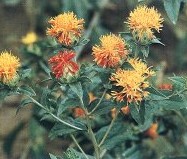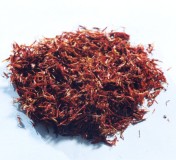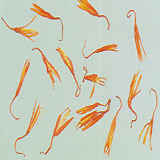Safflower
http://www.100md.com
《e Natural Health Center》
 |
 |
 |
 |
Herbs for Promoting Blood Circulation and Relieving Blood Stasis
Safflower
Latin:
Flos Carthami
Origin:
The flower of Carthamus tinctorius L., an annual plant, of the family Compositae. Native to parts of Asia and Africa, from central India through the Middle East to the upper reaches of the Nile River and into Ethiopia.
, 百拇医药
The safflower plant grows from 0.3 to 1.2 m high. It is in leaf from May to October, in flower from August to October, and the seeds ripen from September to October. The flowers are hermaphrodite (have both male and female organs) and are pollinated by insects. The plant can grow in nutritionally poor soil and requires dry or moist soil. It cannot grow in the shade but can tolerate drought.
Safflower has flowers that may be red, orange, yellow, or white. The dried flowers may be used to obtain carthamin, a red textile dye that was commercially important at one time but has since been replaced by synthetic aniline dyes, except in local areas of southwestern Asia. Safflower has been used as an adulterant of the condiment saffron.
, 百拇医药
Oil obtained from the seed is the chief modern use of the plant. Safflower oil does not yellow with age, making it useful in preparing varnish and paint. Most of the oil, however, is consumed in the form of soft margarines, salad oil, and cooking oil. It is highly valued for dietary reasons because of its high proportion of polyunsaturated fats. The meal, or cake residue, is used as a protein supplement for livestock. Safflower, grown chiefly in India, has been introduced as an oil crop into the United States, Australia, Israel, Turkey, and Canada.
, http://www.100md.com
Safflower is cultivated in China as a blood herb. It is grown in most areas of China and mainly produced in the provinces Henan, Zhejiang, Jiangsu, Sichuan, etc. Harvested when the flower turns from yellow into red in summer, the flower is dried in the air or sun for use when raw.
Properties:
Pungent in flavor, warm in nature, it is related to the heart and liver channels.
Functions:
, http://www.100md.com
Promotes blood circulation to regulate menstruation and removes blood stasis to alleviate pain.
Safflower is ranked third in a survey of 250 potential anti-fertility plants.
Applications:
1. To treat amenorrhea (abnormal absence or suppression of menses) and dysmenorrhea (difficult and painful menstruation) due to blood stasis and postpartum abdominal pain due to blood stasis and qi stagnation:
, 百拇医药
Dispersing in its pungent taste and clearing in its warm nature, and specially entering the blood system, this herb can promote blood circulation by removing blood stasis and remove obstruction from and regulate the flow in the channels.
a) Amenorrhea and dysmenorrhea due to blood stasis and postpartum abdominal pain due to blood stasis and qi stagnation:
This herb is often used in combination and mutual reinforcement with peach kernels, Chinese angelica, chuanxiong (Rhizoma Ligustici Chuanxiong), etc.
, 百拇医药
b) Amenorrhea:
It is used in combination with Chinese angelica, zedoary turmeric rhizome (Rhizoma Zedoariae), cassia bark, etc., e.g., Gexia Zhuyu Tang.
c) Dysmenorrhea:
This herb can be used in combination with herbaceous peony unpeeled root (Radix Paeoniae Rubra), yanhusuo (Rhizoma Corydalis), nutgrass flatsedge rhizome (Rhizoma Cyperi), etc., in order to regulate the flow of qi to alleviate pain.
, http://www.100md.com
It can also be used alone, e.g., Hong Lan Hua Jiu in the book 'Synopsis of Recipes of the Golden Chamber', i.e., this herb is decocted with the addition of wine in order to treat stabbing pain in the abdomen due to blood stasis and qi stagnation.
2. To treat masses in the abdomen, blood stasis with pain in the chest and abdomen, traumatic injuries, purple swelling with pain due to obstruction of blood vessels, etc.:
This herb can promote blood circulation by removing blood stasis, eliminate masses, clear obstructions from blood vessels, subdue swelling and alleviate pain.
, http://www.100md.com
a) Masses in the abdomen:
It is used in combination with burreed (Rhizoma Sparganii), zedoary turmeric rhizome (Rhizoma Zedoariae), etc.
b) Traumatic injuries and swelling and pain due to blood stasis and qi stagnation:
This herb is used in combination with sappan caesalpinia (Lignum Sappan), olibanum, myrrh, etc., or safflower tincture or safflower oil can be rubbed and applied onto the affected part.
, 百拇医药
c) Syndromes of obstruction of heart vessels by blood stasis and epigastric pain due to obstruction of qi in the chest:
This herb is used in combination with cassia twig, Mongolian snakegourd (Fructus Trichosanthis), red-rooted salvia root (Radix Salviae Miltiorrhizae), etc.
d) Coronary disease:
In modern times, this herb has been used alone as tablets or injection for the treatment of coronary disease and certain effects have been obtained in the moderation of angina pectoris (a paroxysmal thoracic pain, with a failing of suffocation and impending death) and the improvement of electrocardiograms (a recording of the electrical activity of the heart on a moving strip of paper).
, http://www.100md.com
e) Cerebral thrombosis and thromboangiitis obliterans (a progressive occlusive disease of the blood vessels in the lower extremities):
Safflower injection has been used for intravenous dripping in the treatment of cerebral thrombosis and thromboangiitis obliterans. For the treatment of thromboangiitis obliterans, this herb can also be used in combination with Chinese angelica, red-rooted salvia root (Radix Salviae Miltiorrhizae), olibanum, myrrh, etc.
, 百拇医药
3. To treat dark skin eruption, maculae (a stain, spot or thickening) and papulae due to heat stagnation and blood stasis:
As this herb can remove heat from the blood and clear away toxic substances with its cool nature, it can promote blood circulation and relieve skin eruption, maculae and papulae. In this respect, foreign safflower (saffron crocus stigma) is better.
a) Dark skin eruption, maculae and papulae due to heat stagnation and blood stasis:
, 百拇医药
It is often used in combination with Chinese angelica, Asian poccoon root (Radix Arnebiae seu Lithospermi), Dyer's woad leaf (Folium Isatidis), etc., in order to promote blood circulation, remove heat from the blood, purge heat and clear away toxic substances, e.g., Danggui Honghua Yin in the book 'The Complete Works on Treatment of Measles'.
b) Erythema multiforme (a rash that results from an allergic response, most often secondary to a drug):
, 百拇医药
In modern times, safflower injection has been used for intramuscular injection in the treatment of Erythema multiforme.
Dosage and Administration:
3-10 g.
Decoct for oral administration. Use an adequate amount externally.
Cautions on Use:
This herb should be avoided by pregnant women and no excessive administration should be made to anyone with a tendency to bleed.
, 百拇医药
Safflower should not be stored for longer than 12 months.
Reference Materials:
'Newly Revised Materia Medica' :
"Lockjaw, blood stagnation and various types of postpartum disorders."
'Supplement to Amplified Materia Medica' :
"Safflower can resolve blood stasis and nourish the blood. A large dose can remove blood stasis, while a small dose can nourish the blood."
, 百拇医药
'The Compendium of Materia Medica' :
"It can promote blood circulation, remove dryness, kill pain, dissipate swelling and restore menstrual flow."
Toxic or Side Effects:
Modern Researches:
This herb contains safflower oil mainly containing palmitic acid, stearic acid, arachidic acid, oleic acid, linoleic acid, etc.
, http://www.100md.com
Modern research has shown that the flowers can reduce coronary heart disease and lower cholesterol levels. The water extract of safflower can stimulate the heart and increase the blood flow in the coronary disease to mild extents. Safflower yellow has a certain antagonism against arrhythmia caused by aconitine. It can inhibit platelet agglutination and increase fibrinolysis.
Safflower is also used to treat menstrual pains and other complications by promoting a smooth menstrual flow.
, http://www.100md.com
In domestic practice, the flowers are used in treating infants complaints such as measles, fevers and eruptive skin complaints.
Externally, they are applied to bruising, sprains, skin inflammations, wounds, etc.
The plant is febrifuge (reduces fever), sedative, sudorific (causing sweat) and vermifuge (expels worms from animal bodies). When combined with Ligusticum wallichii it is said to have a definite therapeutic effect upon coronary diseases.
, 百拇医药
The flowers are anti-cholesterolemic, diaphoretic (promotes perspiration), emmenagogue (promotes menstrual discharge), laxative (promote evacuation of the bowel), purgative, sedative and stimulant.
The oil is charred and used to heal sores and treat rheumatism. In addition, safflower oil can reduce blood fat.
The seed is diuretic, purgative and tonic. It is used in the treatment of rheumatism., 百拇医药